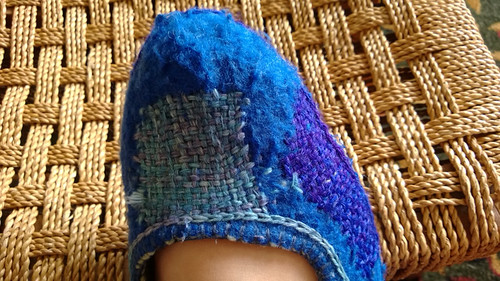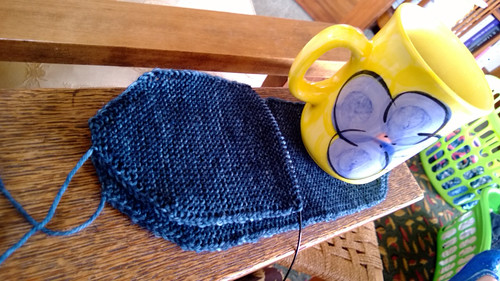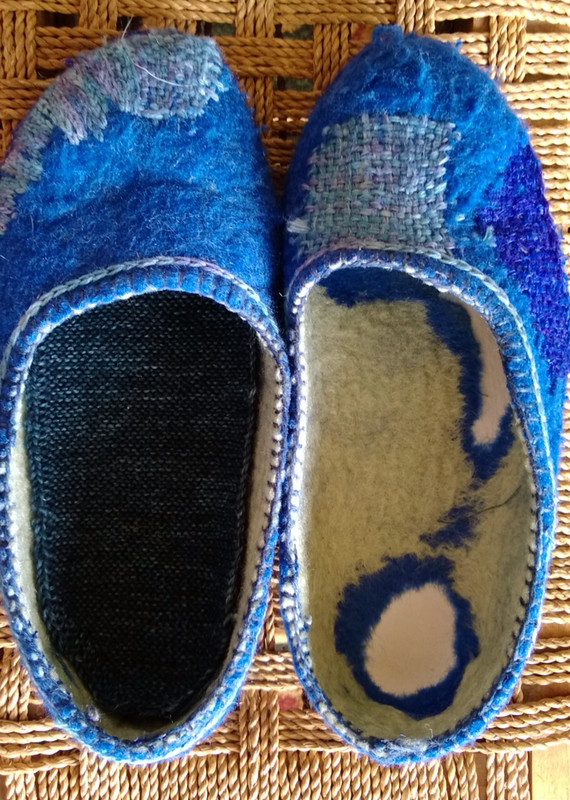So is is the potential frog, a circular washcloth, pattern by Sara Lamb, published in November/December 2013 Piecework. I love the pattern, and the construction, I even love the yarn, a linen I was gifted some years ago. What I don't like is the way it is knitting up on 2.25 mm needles, I want a firmer gauge and I don't want to go down a needle size ... So that means frogging and finding a slightly thicker cotton yarn. Best to do that now ... With only a littl section worked.
It is an entirely different story with these socks, I love these. The local knitter who I copied the idea from asked if I was going to work the Dutch Heel. That sounded like a challenge, a knitting challenge, but I was working toe up not top down and unfamiliar with the finer construction and maths of the dutch heel. Enter the amazing hive mind of ravelry and I had enough help to complete the heel. Not only that but I love the fact that this heel has a rather long heel flap, and that the lower edge of the flap curves under the ball of the foot providing the double stitch layer for where sock wear happens most.
Getting past th heel means that the leg was quickly knit and now I'm working the contrasting cuff. Bear chose the yarn and I think had a more textured sock in mind, but I'm knitting the sock and I love the drama of the colour block toe and cuff. He seems to accept that and has admired the sock several times.
In th background there is some spinning, blue toned spinning, my favorite kind. The little wheel is a Phillip Poore Wendy, designed to be portable. The urban legend goes that this is a wheel one can spin on whilst a passenger in the front of a vintage VW bug. I dont have the opportunity to test that., so I can't possibly comment. I can't read while a passenger so I doubt spinning would work with me and my chemistry anyhow. The wheel is on a two year loan from a local spinner/knitter/raveler who is headed stateside for two years. I love it, it's a sweet wee wheel, I've already done some minor maintenance, changed the drive band to something finer, adjusted the angle of the conrod relative to the wheel weights, and played with the tension. This weel has a rather unique (different, odd, weird, wonderful?) tension system, it is a double drive but the bands are tightened by turning a wooden globe that in turn raises or lowers a copper hoop that both supports and encircles the flier and whorls. The threads that the wooden globe turns on are fine, allowing minute adjustment, but I'm forgetful so never remember if I'm turning clockwise or anti ... I'm still firmly in the learning loop here. I have to confess that two weeks ago I bid on one for myself on TradeMe, and after some frantic last minute bidding and the auction auto extending won a fine example for myself. It's in Wellington, so Bear and eldest cub are heading out to collect it on the 13th. My Christmas present.
The bread is improving every session, I'm getting better at shaping the loaves, and realize that despite the book saying it will only need a final rise of an hour or so ... I get a better crumb if I leave it for longer. I'm still playing with the technique from artisan bread in five minutes a day ....
And finally it spring, or has been so for a wee while, but now it's properly spring and things are blooming. I couldn't resist these at the market this weekend ...,pink peony's which have opened up amazingly since we plopped them in a vase in the living room.
Take care, more next week, na Stella



















